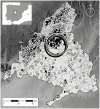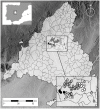Spatial dynamics of bovine tuberculosis in the Autonomous Community of Madrid, Spain (2010-2012)
- PMID: 25536514
- PMCID: PMC4275235
- DOI: 10.1371/journal.pone.0115632
Spatial dynamics of bovine tuberculosis in the Autonomous Community of Madrid, Spain (2010-2012)
Abstract
Progress in control of bovine tuberculosis (bTB) is often not uniform, usually due to the effect of one or more sometimes unknown epidemiological factors impairing the success of eradication programs. Use of spatial analysis can help to identify clusters of persistence of disease, leading to the identification of these factors thus allowing the implementation of targeted control measures, and may provide some insights of disease transmission, particularly when combined with molecular typing techniques. Here, the spatial dynamics of bTB in a high prevalence region of Spain were assessed during a three year period (2010-2012) using data from the eradication campaigns to detect clusters of positive bTB herds and of those infected with certain Mycobacterium bovis strains (characterized using spoligotyping and VNTR typing). In addition, the within-herd transmission coefficient (β) was estimated in infected herds and its spatial distribution and association with other potential outbreak and herd variables was evaluated. Significant clustering of positive herds was identified in the three years of the study in the same location ("high risk area"). Three spoligotypes (SB0339, SB0121 and SB1142) accounted for >70% of the outbreaks detected in the three years. VNTR subtyping revealed the presence of few but highly prevalent strains within the high risk area, suggesting maintained transmission in the area. The spatial autocorrelation found in the distribution of the estimated within-herd transmission coefficients in herds located within distances <14 km and the results of the spatial regression analysis, support the hypothesis of shared local factors affecting disease transmission in farms located at a close proximity.
Conflict of interest statement
Figures



References
-
- Collins JD (2006) Tuberculosis in cattle: Strategic planning for the future. Vet Microbiol 112:369–381. - PubMed
-
- Cousins DV, Roberts JL (2001) Australia's campaign to eradicate bovine tuberculosis: the battle for freedom and beyond. Tuberculosis (Edinb) 81:5–15. - PubMed
-
- Menzies FD, Neill SD (2000) Cattle-to-cattle transmission of bovine tuberculosis. Vet J 160:92–106. - PubMed
Publication types
MeSH terms
LinkOut - more resources
Full Text Sources
Other Literature Sources

